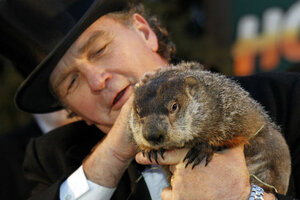Groundhog Day: Parenting odds and ends for a secondary holiday
When is Groundhog Day? Saturday, Feb. 2. -– tomorrow. Share the quirky history of Groundhog Day with your kids, and honor Punxsutawney Phil with a shadow (puppet) of your own.

Groundhog Day is tomorrow, Feb. 2. What are you doing to commemorate the day with your children? Groundhog handler John Griffith holds famed weather prognosticating groundhog Punxsutawney Phil in 2012.
Reuters
Groundhog Day, Feb. 2, has basically everything going for it that I love in a holiday: It marks a point in a season; it’s full of folklore and wisdom, superstition, ceremony, civic charm, science, mystery, agrarian history, and weather; and it was featured in perhaps my all-time favorite movie of the same name, which itself is a study in acceptance and inner calm while being outright hilarious in nearly every frame.
Altogether now: It’s Groundhog Day!
In an early morning ceremony, groundhog Punxsutawney Phil will rise as he has for 125 years from his heated burrow at Gobbler’s Knob, Pa., and signal to his handlers whether or not he sees his shadow. No shadow means an early end to winter. And if the groundhog does see his shadow? Six more long weeks of the season. Over the years that the ceremony has taken place, Phil has seen his shadow 98 times and not seen it only 17. (Records don’t exist for every year.) In 2008, the crowd heartily booed the prospect of “six more weeks of winter”.
Some have stated that Phil’s “handlers” make the prediction for him. What do we think of that?
History and science of Groundhog Day
According to this excellent Groundhog Day site, German settlers arrived in the 1700s to an area northeast of Pittsburgh, Pa. that had been settled previously by the Delaware Native Americans. The Germans celebrated Candlemas Day, originally a Medieval Catholic holiday, to mark the mid-point between the Winter Solstice and the Spring Equinox in the Northern Hemisphere. The holiday also has roots in Celtic-Gaelic and Pagan cultures, where it is celebrated as St. Brigid’s Day and Imbolc, and is a time of festivals, feasting, parades, and weather prediction, as well as candles and even bonfires to mark the sun’s return.
According to Wikipedia, “Imbolc” comes from an Old Irish word meaning “in the belly.” Among agrarian people, Imbolc was associated with the onset of the lambing season.
The German settlers of Pennsylvania put candles in their windows and believed that if the weather was fair on Candlemas Day then the second half of winter would be stormy and cold. While this has always seemed counter-intuitive to me, this site explains the science of Groundhog Day and that cloudy weather is actually milder than clear and cold. It makes sense, then, that the shadow would portend six more weeks of winter. (A lifelong mystery is solved.)
The English and Scottish had wonderful sayings to mark this occasion:
The serpent will come from the hole
On the brown Day of Bride,
Though there should be three feet of snow
On the flat surface of the ground.
– Scottish saying
(Note the serpent instead of the groundhog.)
If Candlemas be fair and bright,
Winter has another flight.
If Candlemas brings clouds and rain,
Winter will not come again.
– English saying
Punxsutawney’s first Groundhog Day celebration was in 1886, and though other towns, particularly in the eastern US, have Groundhog Day ceremonies — Staten Island Chuck, anyone? — none are as famous as Punxsutawney’s. Some of this may lie with the groundhog’s official name, “Punxsutawney Phil, Seer of Seers, Sage of Sages, Prognosticator of Prognosticators, and Weather Prophet Extraordinary”. Still more popularity, and tourists, has come as a result of the movie Groundhog Day. The first official Groundhog Day prediction in Punxsutawney? No shadow – early Spring.
Groundhog activities and crafts
It’s fun to play with shadows in honor of Punxsutawney Phil and his. Try making hand shadow puppets, something people have been doing since 2,000 years ago in China, where puppet shows were performed by oil-lamp light.
Have someone project a flashlight onto a wall or other surface. Hold your hands between the light and the wall in various shapes to create shadow puppets. Here are some classic ones to try:
Rabbit—Make a fist with one hand. Place the other palm over it and make a peace sign (for ears) with two fingers.
Hawk—Link your thumbs together, with your hands facing away from you. Stretch out your fingers and hands and flutter them like wings.
Spider—With palms facing up, cross your hands at the wrist. Press your thumbs together to form the spider’s head. Wiggle your fingers in a climbing motion.
Wolf or dog—Place your palms together, fingers facing outward. Put your thumbs up to form ears. Let your pinkie drop to form a mouth. Bend your index fingers to create a forehead.
Camel—Lift one arm. Hold your hand in a loosely curved position. Hold the pinkie and ring finger together. Hold the other two fingers together, thumb pressed in. Curve both sets of fingers and hold them wide apart to form a mouth. Your arm, from the elbow up, will be the camel’s neck.
There are also a lot of very appealing shadow and groundhog crafts for Groundhog Day, like this one and others from Motherhood on a Dime.
Shadow or no, here’s wishing you a happy remainder of the winter, a ceremony or two, a dash of lore and wonder, and a fruitful spring.

